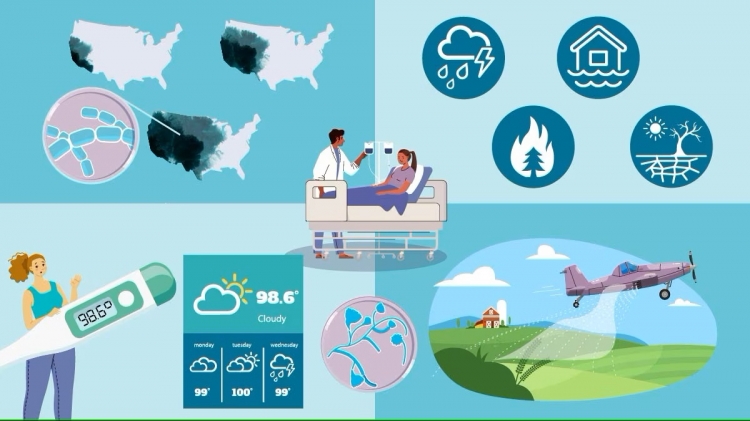Climate and fungal diseases
Centers for Disease Control and Prevention (CDC)
Changes in climate and weather patterns cause fungi to adapt over time. Some disease-causing fungi may start to live in expanded geographic areas that become suitable environments for their survival. New types of fungal infections can emerge if fungi adapt to warmer temperatures and can survive in and infect the human body. There is still a lot to learn about the potential impact of climate change on fungal diseases.
Climate change poses many threats to biological, ecological, and societal systems. Shifting temperatures and weather patterns over time are changing the environment and fungal habitats.
The impact of climate change on fungal infections is not fully understood due to a lack of data. However, there are several ways that environmental changes can transform fungi, where fungi live, and its interactions with other living things:
• Geographic expansion
• Changes to the environment
• Increases in temperature and precipitation may expand the areas where some fungi can survive. For example, the fungus that causes Valley fever, Coccidioides, lives in the soil in hot and dry regions. Coccidioides is usually found in the southwestern United States as well as parts of Mexico and Central and South America. However, presence of the fungus in Washington state was documented in 2015.
Environmental changes may also extend the regions where fungi causing blastomycosis and histoplasmosis survive. The same occurs for fungi found in tropical or subtropical climates, like Cryptococcus gattii.
Population movement
The effects of climate change may cause people to move to new regions of the world. This could lead to overcrowding and poor living conditions. These factors are associated with the risk of ringworm transmission, especially in hot and humid settings.
Extreme weather events
The frequency and intensity of extreme weather events, like large storms, heat waves, droughts, and wildfires, are increasing. These events promote the growth and spread of fungal spores. Flooding from heavy rainfall leads to substantial moisture that can facilitate indoor mold growth.
Other severe weather events, like dust storms, tornadoes, and wildfires, cause environmental disruptions that can spread fungal spores into the air. This causes fungal spores to potentially transport diseases to new locations. Injuries caused by severe weather, like cuts and lesions, can develop fungal infections when exposed to contaminated water or soil.
Fungal adaptation to heat
Only a small percentage of the estimated millions of fungi on earth can infect people. Currently most fungi cannot survive at human body temperatures (around 98.6 degrees F) and need cooler environments.
With shifting temperatures, fungi may be evolving (changing and adapting) to live in warmer conditions, including the human body. New fungal diseases may emerge as fungi become more adapted to surviving in humans. Heat may also cause other genetic changes that can affect the ability of fungi to infect people.
Antifungal resistance
The use of fungicides in the environment may cause increases in antifungal resistance. This means more disease-causing fungi are not killed by the medications designed to treat fungal infections.
Triazole antifungal drugs are the main treatment for several fungal infections, including aspergillosis. Triazole fungicide use is linked to triazole-resistant Aspergillus infections. These infections don’t respond to certain antifungal treatments in the clinic.
Agricultural fungicide use is expected to continue increasing due to rising temperatures. This could lead to new resistant strains of disease-causing fungi.
Further research
It is important to better understand the impact of a changing climate on fungal diseases. CDC monitors trends in fungal diseases to detect new infectious fungi. In addition, CDC conducts statistical modeling work to explore the effects of climate change on:
• Fungi.
• Fungal habitats.
• Seasonality.
• Fungal infections.
How to protect yourself from fungal diseases:
• Learn about fungal diseases and their expanding geographic ranges.
• Ask your doctor to test you for fungal infections.
• Follow guidance to safely clean up mold in your home after disasters.
• Follow your doctor’s instructions when taking antifungal medications.
• Avoid using over-the-counter antifungals without a diagnosis.
